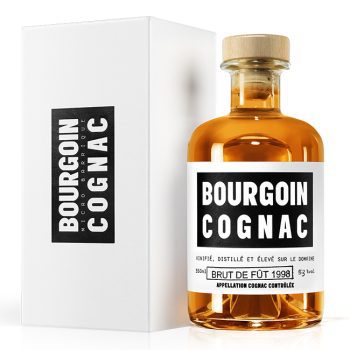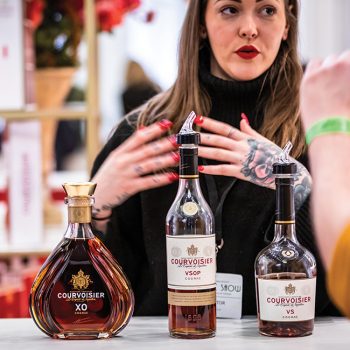Can Cognac weather its current storm?
Cognac is a cyclical business, from the harvests to the popularity of the spirit. Industry insiders reveal the factors causing its decline and how brands can bolster the category’s future.

*This feature was originally published in the May 2024 issue of The Spirits Business magazine.
Facing declines in both of its most important export markets – the US and China – the Cognac category isn’t having the best time at the moment, at least on paper. A variety of factors are at play here, not least the lingering impact of the Covid-19 pandemic, and broader consumer trends too.
Considering the proportion of both countries’ share of Cognac’s exports, a decline in either would make a dent in the category’s overall figures. For perspective, IWSR Drinks Market Analysis describes the US market as more than 10 times the size of the UK’s Cognac market, and more than double that of China’s. “Cognac is largely a two-market category,” says Luke Tegner, IWSR’s director of consulting, adding that between them they account for more than 60% of global Cognac volumes.
According to the latest IWSR figures, those volumes are in decline, with a drop in global volume of 10% between 2021 and 2022.
During the same period, US volumes plunged by 20%, and by 16% in the first half of 2023 compared with 2022, albeit after a rise of 26% from 2019-2020.
China’s volumes, meanwhile, fell by 6% between 2021 and 2022, after a decline of 9% between 2019 and 2020.
As far as shipments go, trade body the Bureau National Interprofessionnel du Cognac (BNIC) reports that “after record shipments in 2021 and 2022”, these dropped by 22.2% in volume in 2023, but returned to growth in the first quarter of 2024.
In light of all of this, the factors resulting in the decline in sales in Cognac’s main markets are multifaceted. Adam Rogers, research director North America for IWSR, offers some context regarding the US. “The cost of living amplified the downwards trend of Cognac, but the segment only appears down if compared with the previous two years,” he says. He identifies one direct impact of the pandemic. “The volume gains experienced during 2020, with a modest increase in 2021, was during the time of pantry-loading, compounded by stimulus checks that increased levels of disposable income.”

The result, he says, is a category that is still cycling through large levels of inventory. Frédéric Bourgoin, who leads Cognac Bourgoin, says: “Covid had a huge impact – the US overstocked, as they feared they wouldn’t be able to ship any liquids during the crisis, the number of available containers fell dramatically, and the cost of shipping went up to six times its original price.”
He adds: “Following Covid, the world went through financial inflation, and the average price of VS went above what usual consumers were willing to spend on an entry-level Cognac.”
François-Gaël Lataste, BNIC director of economy and territorial development confirms this, describing a “combination of logistical and distribution difficulties that have led to a high level of stocks, and the effects of inflation that have affected certain consumption habits”.
The BNIC remains optimistic. “In a changed economic and worldwide geopolitical context, Cognac houses are fully committed to normalising the stocks in their markets, remobilising the American consumer, and confirming the growth of the first quarter of 2024,” says Lataste. “We’re well aware of the cyclical nature of the Cognac world, and it’s our job to know how to manage and anticipate these cycles.”
There’s more than the pandemic to blame for the Cognac category’s decline, though, believes Dawn Davies, buying director of The Whisky Exchange and Speciality Drinks. “The celebs that were driving its popularity in popular culture have moved on to things like Tequila, and away from Cognac,” she says, adding that the growing popularity of other categories such as whisky and rum is a factor too. “Cognac has rested on its laurels a bit.”
For Bourgoin, there’s a generation gap to consider too. “Those consumers who followed in the footsteps of their rap icons by drinking VS Cognac with mixers are now in their 50s, while the drinking habits of the younger generation are different, involving fewer strong drinks.”
Aspirational category
Meanwhile, Cognac’s second-largest market presents its own challenges. “There is some evidence of a slowdown in Cognac’s momentum in China, and Asia generally, as consumers show some push back on increasing alcohol prices,” says the IWSR’s Tegner. “However, Cognac remains embedded as an aspirational category.”
According to the BNIC, shipments to China are in growth too, with 2023 volumes up by 8.2% compared with 2022.

China remains important for producers, Cognac Frapin among them. “We hope to continue to increase our profile in China, even if the economic context seems to be complicated,” says communications manager Thomas Soret, adding that Frapin introduced a new communication strategy there two years ago, aimed at Chinese social networks.
Beyond China, Frapin is looking further afield, says Soret. “We are looking for importers in Asia and Africa who understand our position in the niche market of high-quality Cognacs.” This is understandable. Just take South Africa, now Cognac’s fifth-largest export market, as an example. IWSR reports a rise in volume sales of 17% from 2021 to 2022, following a compound annual growth rate (CAGR) of 14% from 2014 to 2019. The BNIC, meanwhile, reports a rise of 24% in the volume of shipments to the country in 2023.
More broadly, Soret sees an opportunity for the category when it comes to introducing new serves. “The cocktail world is still increasing for Cognac, so it is still one way to attract younger consumers,” he says.
Bourgoin agrees. “Right now, we see an opportunity to listen to younger consumers, to what their needs are, and what they want,” he says. “We suggest long, refreshing drinks like Highballs, with carefully chosen mixers and not too many ingredients, but the right ones – more environmentally friendly, with less sugar, that are less damaging to your health. Staying on the low-alcohol side of things is a good idea at the moment too.”
Davies agrees that serves like these are a good way to introduce new consumers. “Simple serves are great for categories like VS and VSOP, and the more they are used in cocktails, the more consumers will be exposed to them,” she says, but adds there’s more to it. “The stories and the history are what we need to focus on, to capture the heart and imagination of the consumer.”
There’s no shortage of potential, Davies believes, and growing interest too, if the rising numbers of attendees year on year at The Whisky Exchange Cognac Show in the UK are anything to go by. “Pound for pound, Cognac is one of the best-value spirits out there, and has a lot of potential to get new customers into the category, as it is a very approachable spirit,” she says, adding the issues lie rather with outdated packaging, and the language used. “The understanding of categories such as VS and VSOP, in a world where numbers are everything, may not serve a purpose in the way they did before.”
Education, too, is key. “Cognac needs to go back to basics to talk about the quality of the liquid, the land, and the time it takes to create this beautiful liquid,” says Davies.
Bourgoin agrees about the importance of “good communication about the quality of your liquid, and what values are involved. In our case, a small winegrower and distiller, family-led, making our own liquids from grape to bottle, respectful of nature and being more on the quality than the quantity side.”

Weather challenges
Soret echoes this, pointing out that focusing on quality has helped Frapin to weather challenges. “It’s difficult to speak for Cognac in general, but we can say that we have a specific position in the market, dedicated to high-quality Cognac with long ageing. Thanks to this, we are not as exposed to the cocktail or VS market that has declined in the US,” he says.
The right kind of communication, he agrees, is important. “We have to let people know how we make the Cognac, why the terroir of Grande Champagne is important, as is the distillation with lees, and our specific ageing in dry or humid cellars.”
Much like the benefits seen by those operating at the higher-quality end of the market, smaller producers have their own advantages at the moment too. Bourgoin believes the global declines are affecting the major houses more than the small players. “The key négociants have focused on the core markets for as long as we can remember, which explains their investments toward the two major markets,” he says. “It’s left some space for small producers to reach out to smaller markets, with smaller distributors and wholesalers.”
As Davies puts it: “Small brands have a real opportunity at this time, as they have the agility to move quickly.”
The larger players, meanwhile, have their work cut out for them, in Cognac’s established and emerging markets alike.
What would help to future-proof the Cognac sector as it deals with challenges such as climate change?
Francis Abecassis – owner, Domaines Francis Abécassis
“On ABK6 Cognac vineyards, sustainable growing methods are used to best respect the environment and the vineyard. New sustainable techniques are studied and developed continuously by our teams. Nowadays with the temperatures rising and the more frequent heatwaves, we aim to create shade to protect the clusters. Then, we tend to preserve inter-row soils and nature to promote the development of organic matter that will retain water during dry periods. Additionally, the implementation of winter cover crops helps to introduce organic matter that will eventually become mineral matter and will nourish the vines; thus, reducing the use of phytosanitary products.”
Bénédicte Hardy – world brand ambassador and North America sales manager, Hardy Cognac
“Thirteen years ago, when we decided to launch an organic VSOP, it was because the challenges of using an increasing number of pesticides and herbicides was not a good choice for Mother Nature. Everyone in Cognac now seems to agree that we have to work in the same direction. In my opinion, it is what will future-proof our industry. Working with hybrid grapes that are more drought resistant, or old ones that can endure heat better than Ugni Blanc is already in place. It will take years to complete but our industry will grow stronger, and many generations will enjoy our eaux-de-vie.”
How is your company aiming to modernise the Cognac industry?
Thomas Soret – communications manager, Cognac Frapin
“The cocktail world is still increasing for Cognac, so it is still on the way to attracting younger consumers. But in our opinion, we are certain that education is the key. We have to let people know how we make the Cognac, why the terroir of Grande Champagne is important, also the distillation with lees and our specific ageing in dry or humid cellar.
“Cognac Frapin, due to its position in the niche market of high-quality Cognac, does not follow trends. We focus on high quality so we need time and know-how to create our range of Cognac.”
Related news
Why Cognac is stuck in limbo land
